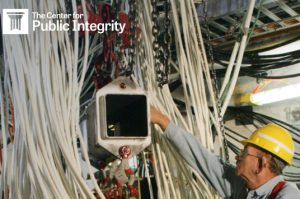Above its masthead the hard copy 12/4/09 Sandia Lab News has a cool NNSA/DoD “W76-1/MK4A” badge with a black submarine and a vertical warhead above it with a slanted trident across it. MK4A is the reentry vehicle for the W76. The sub, of course, is a Trident submarine.
To summarize some points:
• It states that Life Extension Programs (LEPs) can extend warhead life up to 60 years. That’s significant, especially given the continuing push by some for new-design replacement warheads. Previously I had heard only up to 30 years.
• Please note the pending resumption of broad-scale nuclear weapons production with this W76 LEP.
• Please note “reinventing the weapon’s AF&F [arming, fuzing & firing] system” …. which “provides packaging and performance enhancements. Though the W76-1 is emphatically not a new weapon system, the scope of the LEP effort was very demanding.”
Maybe it’s not a new “system,” but the W76-1 has new military characteristics. That new AF&F system being produced now at the Kansas City Plant is believed to endow the warhead with a selectable height of burst.
In 1997 Navy Admiral George “Pete” Nanos wrote :
The demonstrated capability of the D5 [the new Trident II missile] is excellent. Our capability for Mk 4 [reentry vehicle with W76 warhead], however, is not very impressive by today’s standards, largely because the Mk 4 was never given a fuse that made it capable of placing the burst at the right height to hold other than urban industrial targets at risk. With the accuracy of D5 and Mk 4, just by changing the fuze in the Mk 4 reentry body, you get a significant improvement. The Mk 4, with a modified fuze and Trident II accuracy, can meet the original D5 hard target requirement. Why is this important? Because in the START II regime, of course, the ICBM hard target killers are going out of the inventory and that cuts back our ability to hold hard targets at risk.
“Strategic Systems Update,” Rear Admiral G.P. Nanos, The Submarine Review, April 1997
In other words, with a new fuze and increased missile accuracy the military characteristics of the refurbished W76-1 are transformed from being a countervalue weapon of deterrence (“city buster”) into a counterforce weapon (“hard target killer”). This directly contradicts the constantly repeated statements by senior U.S. Government officials that military characteristics won’t be changed and that “new” nuclear weapons will not be created.
For more, please Hans Kristensen’s excellent 2007 “Administration Increases Submarine Warhead Protection Plan”
(Side note: Adm. Pete Nanos later became LANL Director, didn’t quite get along, and at one point famously called Lab scientists “cowboys” and “buttheads”).
The article ends by noting that the W76 LEP has laid the foundation for a future B61 LEP, which itself is an issue of current controversy.
Separately it was recently revealed that Sandia manager Lockheed Martin pays Sandia Director Tom Hunter $1.7 million a year. Lockheed Martin is also the dominant corporate partner running the U.K’s Atomic Weapons Establishment (AWE) at Aldermaston. On December 4 the Obama Administration nominated Donald Cook to be NNSA Deputy Administrator for Defense Programs. Cook is an American who worked at Sandia for 28 years and was the Managing Director of the UK’s AWE from 2006 to 2009. The W76 is the U.K’s main (if not only) currently operational nuclear weapon.
I find the overarching headline in this e-version of Sandia Lab News announcing that Sandia technology “comprehensively” supports the CTBT to be ironic while it then goes on into an article about broad-scale nuclear weapons production of the W76-1. I understood the original intent of the CTBT to be a disarmament treaty cutting off the further advancement of nuclear weapons by any country.

